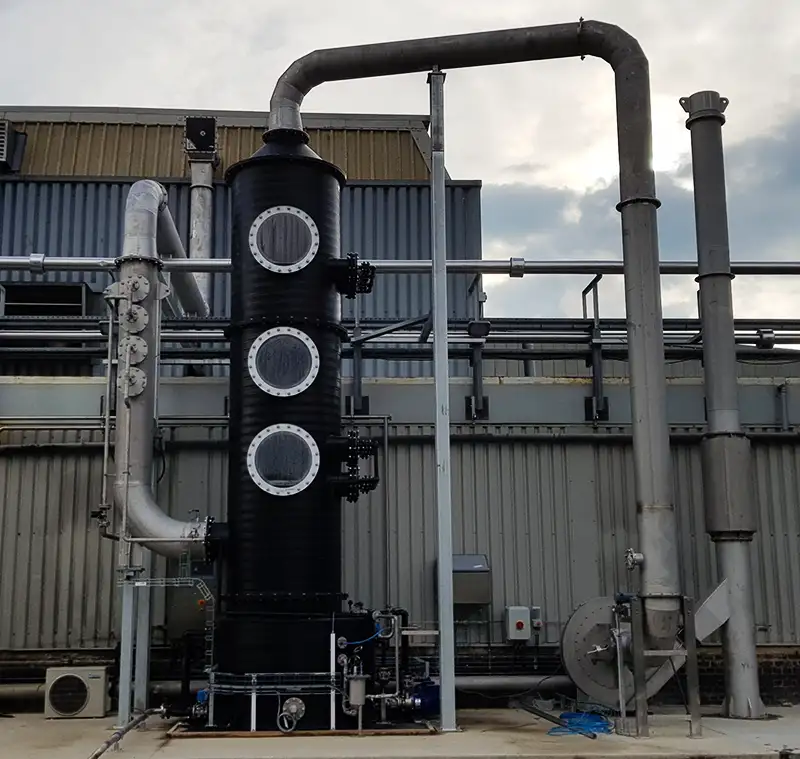Avoiding Odor Nuisance: Emission Control with Wet Gas Scrubbers
 In (chemical) processes, odor-bearing components or aerosols can be originated under certain
conditions and end up in gas streams. In respect of the current legislation and nuisance to the
environment, it is necessary that these odors are removed by, for example, a wet gas scrubber.
In (chemical) processes, odor-bearing components or aerosols can be originated under certain
conditions and end up in gas streams. In respect of the current legislation and nuisance to the
environment, it is necessary that these odors are removed by, for example, a wet gas scrubber.
What causes odor nuisance — and how to mitigate it
Especially in the chemical and food industry, there is frequently a certain level of odor nuisance. This is often caused by relatively small gas particulates that could be bonded to (bigger) dust particles. These extremely small particulates are often described as aerosols. The aerosols must be removed from the gas stream at the end of the process before the gases are discharged to the outside air. If the aerosol consists of fairly small particles (<5 μm), a gas scrubber or scrubber is often used for this. Such a scrubber is often constructed as a vertical column with various internals and components. The spectrum determines the configuration of the scrubber. The smaller the contaminated particulates, the more complex the scrubber.
Challenge
The removal of the aerosols is a major challenge as they are sometimes exceedingly difficult to eliminate. However, it is first necessary to establish what the load is and what the spectrum is for the purpose of configuring the scrubber.
Several washing stages
The measurement of odor emissions is conducted differently than the more common emission measurements of gases. This means that an odor scrubber also has a different construction than a gas scrubber or dust scrubber. An odor scrubber almost always consists of a combination of several stages:
- Oxidative.
- Acidic.
- Alkaline.
- Neutral (mostly water).
These stages can be used separately but also in combination with each other.
Odor concentration measurements
Sensory odor measurements determine how many times a gas sample must be diluted with clean (odor-free) air, so that half of a panel of test subjects can no longer distinguish the diluted sample from clean air. The dilution number (=diluted volume/ original volume) is then the numerical value of the odor concentration expressed in odor units OU/m3. The gas sampling for odor concentration measurements is done by collecting gas samples from the waste gas in inert odor sample bags. The odor concentration of the collected samples is then determined.
Measuring odor concentration (ouE/m³) & compliance
Odor performance is verified by measuring odor concentration (ouE/m³), commonly according to EN 13725. For process monitoring, gas analyzers (e.g. H₂S, NH₃ in ppm) complement periodic olfactometry. Define limits, sampling points and test frequency in your site’s odor management plan.
Need a refresher? See our guide: What is odor concentration (ouE/m³)?
FAQ
How do gas scrubbers control odor emissions?
By contacting the gas with a conditioned liquid in a wet scrubber. Odorous molecules dissolve or react in the liquid, lowering the outlet concentration and reducing odor nuisance.
Which contaminants are typical in odor control?
Common targets are hydrogen sulfide (H₂S), ammonia (NH₃), mercaptans and certain VOCs. The exact mix depends on the process.
What odor removal efficiency can I expect?
It depends on solubility/reactivity, design and operating conditions. Properly designed wet scrubbers typically achieve high removal for soluble/reactive compounds such as H₂S and NH₃ (often >95%). Final performance should be verified by measuring odor concentration (ouE/m³) and meeting site limits.
What information do you need to design/select a scrubber?
Key inputs include: gas flow (Nm³/h) and variability, temperature/humidity, target compounds and inlet concentrations (or worst-case peaks), required outlet/limits, available utilities (water/chemicals), layout/footprint and any constraints (pressure drop, noise, materials).
More sustainable production processes thanks to tailor-made scrubber
Our wet gas scrubbers make it possible to purify up various gas flows. This leads to a cleaner living environment and more sustainable production processes. Curious about the possibilities? Our specialists will provide you with the appropriate recommendation. Feel free to contact us and we will look for a suitable solution together with you.
